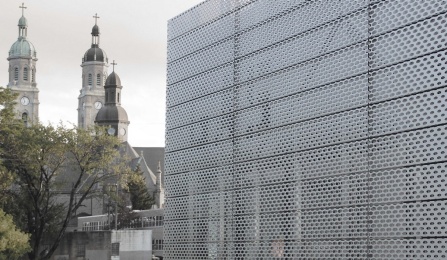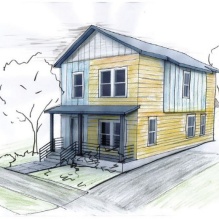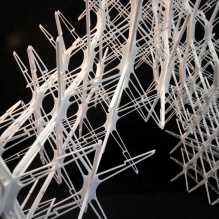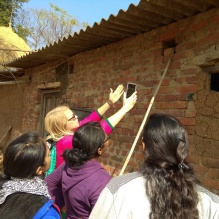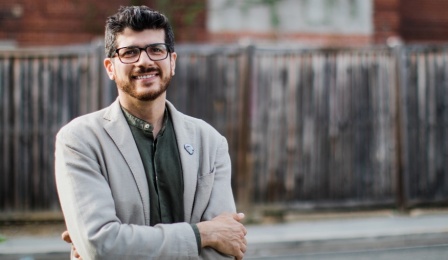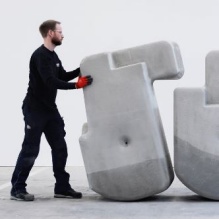Issue #2: Materials and building
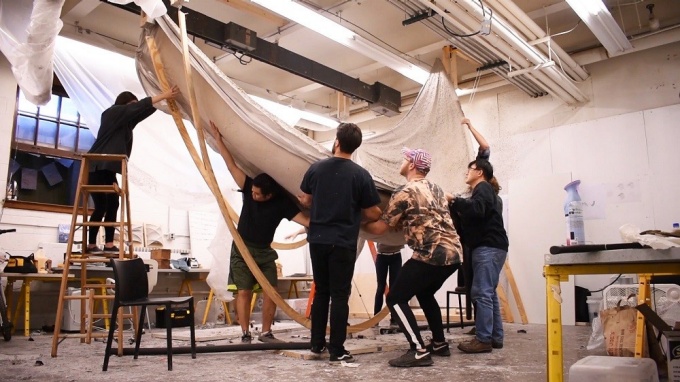
Graduate architecture students in the material culture studio "Pulp" experiment with a thin-shell catenary using only fabric, cellulose insulation and flour. The project is part of ARC 605, "Pulp," directed by Stephanie Davidson and Georg Rafailidis, which explores the structural potential of paper casting as an investigation in temporality and biodegradabiilty in architecture.
Remaking form and fabric
The methods, modes and materiality of building shape not only the form and function of our built environment, but societal aspirations for cultural production, social justice and resilience.
The School of Architecture and Planning's legacy in experimental making, fabrication and adaptations of existing urban fabric positions our faculty, students and alumni in the center of this discourse. From new models of building and funding affordable housing, to experimental facade designs with steel and terra cotta, to new thinking about what counts as historically significant urban fabric, this body of work suggests the power of rethinking how we make across all scales.
How are you pushing the "plus" of future practice in our disciplines? Tell us how for a chance to be featured on our "Be the Plus" blog. Contact Rachel Teaman, assistant dean for communications: rmansour@buffalo.edu
Commemorating our 50th anniversary, "Be the Plus" invites you to join us in considering new possibilities for our disciplines as creative, innovative and regenerative forces in our world. Learn more about Be the Plus.
Faculty research on building systems and materials
LIGHT/STATION, an innovation in facade technology using thin-gauge metal, stands in the shadows of Buffalo's historic architecture. Photo by Christopher Romano
A perforated metal facade prototype developed by architecture professor Christopher Romano and Buffalo-based Rigizied Metals Corp. has earned an Architect's Newspaper Editor's Choice award for Best of Products in the facade category.
View the latest work to come out of the Architectural Ceramic Assemblies Workshop (ACAW), a hands-on research and development workshop for architects and engineers exploring high-performance facade design with terra cotta. ACAW builds on an eight-year research partnership between UB and Boston Valley Terra Cotta.
Explore design studies, prototypes and publications confronting questions of accessibility, quality and affordability in housing. The work is part of UB's Affordable Housing Initiative, an interdisciplinary research effort that seeks to advance affordable housing prototypes for Buffalo and cities like it across the U.S.
Snap Interlock Module System (SIMS), developed by UB associate professor of architecture Jin Young Song, imagines a new system for building with steel in the 21st century construction industry. The prototype is the winner of the 2019 Forge Prize. Research into manufacturing of the SIMS unit is led by Daniel Vrana (MArch '15, BS Arch '13), fabrication manager in the school's Fabrication Workshop.
In line with our 50th anniversary focus on innovation in building and materials, we take a look back into the catalog of Professor Annette LeCuyer, who has authored several books on building technology in contemporary architecture.
Urban planning professor Ashima Krishna reviews case studies of faith-to-faith conversion of vacant churches in Buffalo to places of workshop for immigrant communities as an asset to shrinking cities and those fighting to save urban heritage from demolition.
An urban planning studio that explored the historic value of building typologies along Niagara Falls Boulevard that date back to its origins as a 1950s-era tourist strip has been recognized by the New York Upstate chapter of the American Planning Association.
Studios and student work on building systems and materials

Photo by Georg Rafailidis
Studio Snapshot: "Pulp"
"Graduate architecture students assemble "Cellulose Insulation as Structure," a thin-shell catenary using only fabric, cellulose insulation and flour. The project is part of "Pulp," the fall 2020 Material Culture studio and associated Technical Methods course ”Paper Casting”, taught by Stephanie Davidson and Georg Rafailidis as part of ongoing research on the structural potential of paper casting and investigations in temporality and biodegradability in architecture. Students on the "Cellulose” project team are Craig Brozowski, Michael Hoover, Morgan Mansfield and Abigail Peters."
A recent study by MArch/MUP student Nicole Little addressed a costly building challenge in rural Jharkland, India, where traditional mud-wall homes were degrading due to water penetration. As an alternative to government proposals for concrete construction, Little conducted soil studies and consulted with local experts to recommend alternative materials and traditional engineering technologies that would add durability while maintaining cultural relevance and affordability.
Justina Dziama's MArch thesis, Millimeter of Space, explores the topography of Buffalo's decaying industrial architecture and the impact of time on material. Using the surface of Buffalo's grain elevators as her subject, Dziama creates a record of natural material transformation through a series of hyperphysical latex castings. Dziama has dedicated her thesis to her grandfather, a Ukranian immigrant who worked in Buffalo's steel industry.
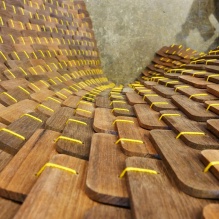
Explorations into Cages and Logging
The recent "Cages" studio explores qualities of material boundaries and enclosing conditions that relate structure and skin, establishing critical connections between natural and artificial material experience.
"Logging" investigates latent material possibilities within the medium of wood by investigating origins and ethics of material consumption – two societal conditions that humans have increasingly become disconnected from.
Alumni contributions on building systems and materials
Omar Hakeem is leading work on social and environmental sustainability as design director of bcWORKSHOP, a community design center based in Texas.
Follow Omar Hakeem and his team at bcWORKSHOP for an INSTAGRAM TAKEOVER as they lead site visits and a community workshop on affordable housing in Brownsville, Texas. Live on Instagram / Thurs, Dec. 12: 10 AM - 6 PM EST / Fri., Dec. 13, 10 AM - 12 PM EST
Omar Hakeem (BS Arch '06), design director at bcWORKSHOP in Washington D.C., discusses the community design center's "MiCasita" model, a housing delivery and financing model that brings choice, quality and affordability to the impoverished Texas Rio Grande Valley.
As a community planning and development representative for the U.S. Department of Housing and Urban Development's field office in Buffalo, Caitlin Donovan oversees a portfolio of affordable housing and economic development grants across the upstate region.
Architecture alum Matthew Meyers (MArch '16), a materials and products design specialist at CEMEX in Switzerland, participated in an experimental masonry project exhibited at TED2019 in Vancouver. The work explores ancient construction and assembly methods using monumental sized concrete modules.
MSRED graduate Connor Kenney reflects on his work on innovative affordable housing projects at Rochester, N.Y.-based PathStone Corp., the biggest challenges facing the affordable housing field, and and the potential for real estate development to create meaningful change for communities.
